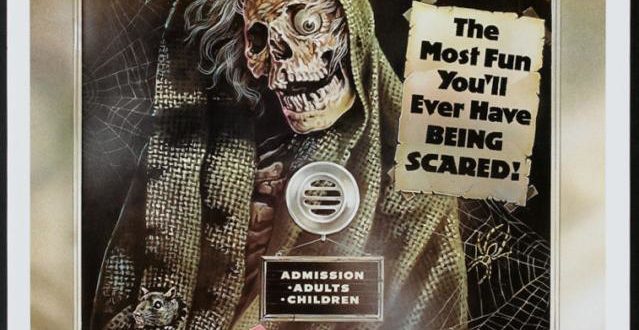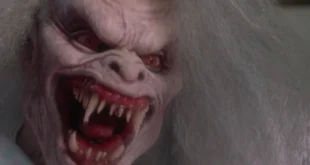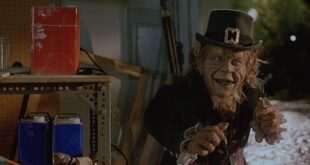Revenge is a tried and true theme in the arts, and horror cinema is no exception. Enter the world of Creepshow (1982). Written by Stephen King, directed by George A. Romero, and with practical effects by Tom Savini, Creepshow illustrates what can happen when horror icons unite. Seriously, a team like that is practically every horror fan’s dream! Story-wise, it is a magical black comedy horror anthology, and each tale brims with tasty revenge (or at least hints at it).
Creepshow’s wraparound prologue/epilogue introduces a young lad named Billy (Stephen King’s son, Joe King) getting harangued by his stern father (Tom Atkins). Billy’s crime? Reading trashy comic books, of course! This is a perfect setup for what is to come. For one thing, many of the old horror comics (Tales From The Crypt, The Vault of Horror, etc.) featured gruesome acts of revenge. How could this movie not do so?
Also, many kids had similar experiences facing off against boring, normal adults who just couldn’t understand such material. Undoubtedly, such treatment can create resentment in kids — especially when parents actually confiscate their beloved comic books. So, by the end of the film, Billy has a unique method of revenge that perfectly ties in with the comics themselves.
Father’s Day

The first big story, “Father’s Day,” actually deals with two characters’ methods of revenge. In the process, we see how sinister (and darkly humorous) revenge and overbearing control can be. Nathan Grantham (Jon Lormer) is a twisted, wealthy criminal and murderer who obviously pushed his antics to the limit.
In a flashback, we see that, after years of putting up with him, Mr. Grantham’s daughter, Bedelia (Viveca Lindfors), finally reached a breaking point. Not only did he at one point murder Bedelia’s love interest, but, on a certain Father’s Day, his incessant demand for cake led her to whack him over the head. The blow proved fatal and the authorities couldn’t pin his death on her (apparently, forensic science wasn’t in full swing).
However, blunt force trauma would not solve all of Bedelia’s problems. Years after the murder, she still returns to his gravesite every year on the anniversary of his death, which her family celebrates. Before long, however, we get to see a mostly skeletal, miserly old Nathan Grantham rise from the grave to demand a Father’s Day cake. No one is safe! Certainly not Bedelia, and not even a disco dancing Ed Harris.
It is undoubtedly a memorable tale, made with both humor and a comic-book style. It’s the sort of tale where rationalization for vengeance simply does not matter. The spite of it all, it was enough to raise someone from the dead and to make others die. It’s simple yet effective. You can’t have your cake and eat it, too, but you can certainly try!
The Lonesome Death of Jordy Verrill
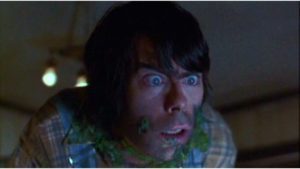
At first glance, the second story might not seem like a vengeance tale. However, this has more to do with subtlety compared to the previous tale. Jordy Verrill — wonderfully played by Stephen King himself — is a very simple man. Still, as this story progresses, we get a strong whiff of his underlying motivations and sense of failure.
When he finds a meteor on his property, he no doubt believes it will bring him fame and riches and make others envious of his newfound greatness. Jordy wants power over his life and the ability to pay off a pesky bank loan. More to the point: He wants his life to turn around, to tell others what to do (for a change), and to finally have good luck.
Unfortunately, the meteor turns out to be a curse, not a blessing. “Meteor shit” gets all over him, and in fact gets all over everywhere, and fast. What cruelty, fate!
Something to Tide You Over

Make no mistake about Richard Vickers (Leslie Nielsen). He is another wealthy psychopath, and, much like Nathan Grantham, he’s not afraid to let his freak flag fly. An extremely possessive man, Richard can’t stand the idea of his wife, Becky (Gaylen Ross), being involved with Harry (Ted Danson). What does he do about it? He shows up at Harry’s place, makes a vague threat about Becky’s life, and takes Harry at gunpoint.
They travel to Richard’s expansive beachfront property, where a rather devilish surprise is in store. What unfolds is a brilliant example of revenge as depravity, and of someone who takes possessiveness and ownership way too far.
Richard’s sadistic revenge may initially be successful, but the aftermath puts him to the test. In the world of Creepshow, revenge knows no bounds, and Richard’s resolve will be cracked — it has to be! Also, the quality of Leslie Nielson’s performance deserves special note. His performance is truly convincing and just oozes with a sense of paranoia and the desire to call the world his.
The moral? Never trust someone with beachfront property and top-of-the-line VCR equipment.
The Crate

Another simple yet effective Creepshow creation, “The Crate” is both a creature feature and a revenge tale. You see, Professor Henry Northrup (Hal Holbrook) really hates his wife, Wilma “Billie” Northup (Adrienne Barbeau). Why? She is a foul-mouthed, obnoxious, controlling and condescending alcoholic.
What, exactly, is there to love? In fact, Henry regularly fantasizes about doing away with her (perhaps divorces weren’t invented yet). Interestingly for us viewers, Henry may have that opportunity.
Henry’s fellow professor, Dexter Stanley (Fritz Weaver), relates the story of a hidden crate discovered by a university janitor (Don Keefer) — apparently from an Arctic expedition that occurred almost 150 years ago. Inside of the crate was a malicious little monster who essentially devoured the janitor, then hauled the crate back under the stairwell.
The crate monster — who I like to call “Cratey” — may be just the tool Henry needs to shut Wilma up for good, while leaving minimal mess for pesky cleanup. As the tale unfolds, we are left asking the standard question: Who is the real monster here? An obvious answer is Henry. Still, Wilma sure is annoying. You gotta give Henry that much.
They’re Creeping Up on You
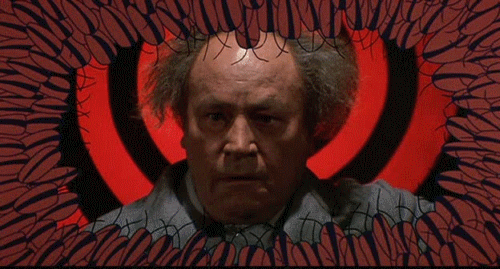
Upson Pratt (E. G. Marshall) may be wealthy, but his ruthless, cut-throat business approach has not made him popular. Living singularly in a sealed apartment, Mr. Pratt is on perpetual lockdown. Though it’s partly for his fear of germs, it’s no doubt also due to his fear and hatred of people. Locked in his self-styled prison, he has surveillance cameras everywhere. In short, Pratt is a perfect representation of the ruthless, paranoid world we inhabit.
Unfortunately for him, his paranoia is increasingly justified, as his place is suddenly infested by cockroaches, and hounded by people he has wronged over the years. A possible moral here: Those who build walls to isolate themselves from life must also live behind them.
If he wasn’t such a bad guy, some people might feel sorry for him. An example of Pratt’s awfulness? When informed that somebody he fired had committed suicide, Mr. Pratt simply gloats about having crushed him like another roach. However, as the roach problem gets exponentially worse, one gets a feeling that it isn’t your average bug problem. It’s like the universe is having its revenge. Although Pratt hates roaches, he should remember that they collectively have a way of surviving. Can Pratt survive them?
In Summation
Although Creepshow isn’t a universally acclaimed picture (for whatever reason), it has a lot of neat elements to it. It also might make people think twice to do wrong, or even to be annoying. You know what they say about karma. That is probably a strength unto itself! Sure, not all obnoxious people receive the Creepshow treatment in real life, but it can happen that way, and often enough will. Here’s to comeuppance!
 PopHorror Let's Get Scared
PopHorror Let's Get Scared
